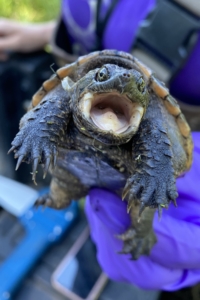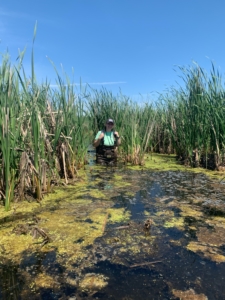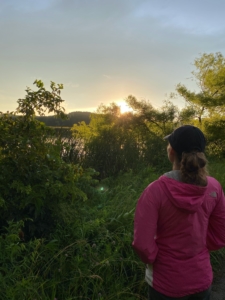 Wow Michelle and Alexis haven’t posted in a while, hope they haven’t been eaten by a snapping turtle. Don’t worry readers, the swamp has yet to take us and we have returned for another blog post. If Michelle could stay awake past 10 o’ clock this would have probably been posted a lot sooner. Our teamwork tends to get a little jammed when one of us passes out eating oreos after a long day of fieldwork. We’ve had some busy days and even a few busy nights, so we thought we’d share some snapshots of our life out here in the marshes.
Wow Michelle and Alexis haven’t posted in a while, hope they haven’t been eaten by a snapping turtle. Don’t worry readers, the swamp has yet to take us and we have returned for another blog post. If Michelle could stay awake past 10 o’ clock this would have probably been posted a lot sooner. Our teamwork tends to get a little jammed when one of us passes out eating oreos after a long day of fieldwork. We’ve had some busy days and even a few busy nights, so we thought we’d share some snapshots of our life out here in the marshes.
For those of you wondering how our campaign against the mosquitoes is going we have good news! Through a combination of deet, citronella, and magic, we have managed to cut down the number of our bug bites by 90.6%. However, we now wage war against the essence of the swamp itself… water. Everyday we head into the marshes with all of our field gear in our non water-proof backpacks. Field gear that includes electronics and important things that should not get wet. Sometimes when you are waist deep in water, (or if you are Alexis and topple over when a cattail looks at you funny), your backpack can get a bit soaked. Of course we put all of our important equipment inside of ziplock bags. The nature of our enemy, (water) is pervasive and we are currently trying place a protective seal around some of our more precious items with an unspecified brand of adhesive tape that could probably waterproof a sponge if it wanted to.
 Continuing on the topic of water, let’s talk about waders. A question we often find ourselves asking during the day is, “sweat or water?”. The waders are incredibly well-made and do not let any water in, unless of course a hole is poked in them. After being warned about holes in our waders, we are hyper-alert when we feel dampness in them. When you step out of your waders and are completely drenched on a 90 degree day, you have to wonder, did you flood your waders? Or did you just sweat out 30lbs of water? Thus far it has mostly been sweat, and the few times waders have been flooded, it was not through a leak but rather because water filled over the top of the waders, (aka falling over in the water). For the record, walking through foot-deep mud in waders is really hard, and quite the work out. The good news is that here in Kane County we have a tradition that anyone who floods their waders gets donuts for everyone. As you might imagine, we’ve eaten a lot of donuts this summer.
Continuing on the topic of water, let’s talk about waders. A question we often find ourselves asking during the day is, “sweat or water?”. The waders are incredibly well-made and do not let any water in, unless of course a hole is poked in them. After being warned about holes in our waders, we are hyper-alert when we feel dampness in them. When you step out of your waders and are completely drenched on a 90 degree day, you have to wonder, did you flood your waders? Or did you just sweat out 30lbs of water? Thus far it has mostly been sweat, and the few times waders have been flooded, it was not through a leak but rather because water filled over the top of the waders, (aka falling over in the water). For the record, walking through foot-deep mud in waders is really hard, and quite the work out. The good news is that here in Kane County we have a tradition that anyone who floods their waders gets donuts for everyone. As you might imagine, we’ve eaten a lot of donuts this summer.
 Last week we also had the chance to go on a night shift with one of the Forest Preserve workers to do egg checks on the female turtles that have yet to lay this season. This means wandering around common, yet unideal, locations to see if we could find any new nests that should be moved. With radio telemetry we tracked a female Blanding’s that was suspected to be laying soon. When she was found and we palpated eggs in her lower abdomen, we decided to bring her into the shop for the weekend in the hopes that she would lay eggs and then be released. Mother Nature is a temperamental and unpredictable lady so she is not to be trusted with a nest of vulnerable Blanding’s eggs if we can help it. And by Mother Nature we are really talking about devious raccoons that dig up the eggs and eat them. There is also a lot of human interference and habitat fragmentation that often leaves Blanding’s nests in less than ideal environments for survival. Therefore, we bring in eggs and incubate them in the shop to increase the chancing of hatching.
Last week we also had the chance to go on a night shift with one of the Forest Preserve workers to do egg checks on the female turtles that have yet to lay this season. This means wandering around common, yet unideal, locations to see if we could find any new nests that should be moved. With radio telemetry we tracked a female Blanding’s that was suspected to be laying soon. When she was found and we palpated eggs in her lower abdomen, we decided to bring her into the shop for the weekend in the hopes that she would lay eggs and then be released. Mother Nature is a temperamental and unpredictable lady so she is not to be trusted with a nest of vulnerable Blanding’s eggs if we can help it. And by Mother Nature we are really talking about devious raccoons that dig up the eggs and eat them. There is also a lot of human interference and habitat fragmentation that often leaves Blanding’s nests in less than ideal environments for survival. Therefore, we bring in eggs and incubate them in the shop to increase the chancing of hatching.
Fun fact: the temperature the eggs are incubated at will influence the sex of the baby turtles inside. Half of the eggs are kept at a cooler temperature and will be male while the other half are at a warmer temperature and will be female. In the next couple months the eggs will hatch and some of the hatchlings will be next year’s headstarts!
